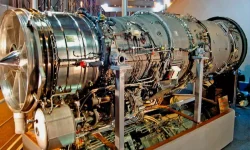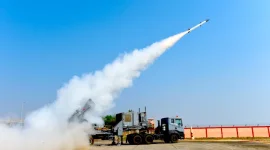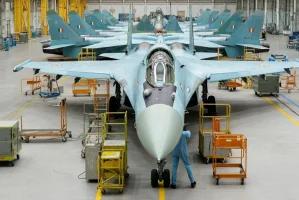- Views: 3K
- Replies: 7
India has reached a significant milestone in strengthening its naval capabilities with the completion of a new submarine construction complex designed for its next generation of nuclear-powered submarines.
Recent reports and satellite imagery confirm that this advanced facility, situated near the Cochin Shipyard, is prepared to begin building the S5-class nuclear ballistic missile submarines (SSBNs). These vessels, displacing a massive 13,000 tons when submerged, represent a major advancement for India's underwater strategic forces.
This development marks a critical step in India's pursuit of a reliable sea-based nuclear deterrent and aligns with the national goal of self-reliance in defence manufacturing under the AatmanirbharBharat initiative.
The purpose-built complex, extending over 600 meters, features infrastructure capable of housing the construction of three S5-class submarines concurrently before they are moved to an adjacent dry dock for final outfitting and launch. This parallel construction capability highlights India's commitment to accelerating its SSBN programme to meet strategic timelines.
The S5-class submarines are substantially larger than their predecessors, the 6,000-ton Arihant-class, nearly doubling their displacement. This increased size accommodates more powerful nuclear reactors, improved stealth technologies, and a greater capacity for submarine-launched ballistic missiles (SLBMs), positioning the S5 class as a future pillar of India's nuclear triad (the capability to launch nuclear weapons from land, air, and sea).
The readiness of this new facility follows notable progress in India's existing SSBN fleet. INS Arighat was commissioned into service in August 2024, joining the lead boat, INS Arihant, on operational patrols. Furthermore, the S4* submarine (reportedly named INS Aridhaman) was launched in late 2024 and is anticipated to be formally commissioned later this year.
The S5 class, however, signifies a leap forward in capability. These submarines are expected to carry between 12 and 16 K-6 SLBMs, which are reported to have ranges between 5,000 and 8,000 kilometers and potentially feature Multiple Independently targetable Reentry Vehicles (MIRVs). This extended range enhances India's second-strike capability, allowing it to credibly threaten adversaries from secure locations within the Indian Ocean region.
Powering the S5-class SSBNs will be a 190 MW Pressurised Water Reactor (PWR), developed indigenously by the Bhabha Atomic Research Centre (BARC). This represents a significant power increase compared to the 83 MW reactors used in the Arihant class. The new reactor design is expected to require refueling only once every decade, offering enhanced operational endurance.
Additionally, the S5 submarines will incorporate pump-jet propulsion systems, which are significantly quieter than traditional propellers, thus reducing the submarine's acoustic signature and improving its stealth – a vital characteristic for SSBNs designed to remain undetected while on deterrent patrol.
Indigenous technological development is central to the S5 project. The Steel Authority of India Limited (SAIL), specifically its Bhilai Steel Plant, has reportedly developed a new grade of high-strength steel suitable for the large hulls of these submarines.
This specialised steel, designed to withstand extreme deep-sea pressures and ensure long service life, is currently undergoing testing. The successful integration of such homegrown technologies underscores India's growing self-sufficiency in designing and constructing complex defence platforms.
From a strategic perspective, the development of the S5-class SSBNs is viewed as essential for maintaining regional stability, particularly considering the naval expansion of other powers in the Indo-Pacific.
For instance, China operates Type 094 SSBNs, which displace around 11,000 tons and carry JL-2 missiles with reported ranges of 7,000 kilometers. India's S5 programme aims to ensure a comparable and credible deterrent capability. The potential future integration of even longer-range missiles, like the developmental K-7 and K-8 (with projected ranges up to 13,000 km), could further solidify India's strategic position.
Despite the progress signified by the new facility, the S5 programme is not without challenges. The advanced SLBMs (K-6, K-7, K-8) are still under development and testing, and their full operational deployment remains some years away. Scaling up nuclear reactor technology and integrating complex systems into the larger S5 hull also present significant engineering tasks.
Furthermore, reports indicate that the initial plan for six S5 submarines may have been revised to four, likely due to the substantial costs involved, with each submarine estimated to cost around $2.4 billion.
However, the facility's capability for simultaneous construction offers potential for an efficient production schedule. If construction commences around 2027 as projected, the first S5-class submarine could potentially enter service by the mid-2030s.
This timeline supports the Indian Navy's objective of maintaining a continuous at-sea deterrence posture, generally requiring a fleet of at least four SSBNs to ensure at least one is always deployed – a standard maintained by established nuclear powers like France and the United Kingdom.




